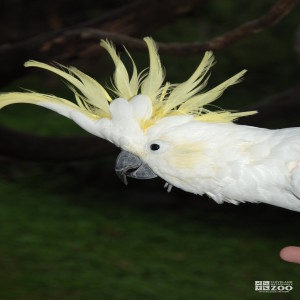Sulphur-Crested Cockatoo
[Cacatua galerita]

The sulphur crested cockatoo is a white bird with a striking erectile yellow crest, and a yellow suffusion on the underside of the wings and tail. Body length ranges from 18-22 inches long. The eye-ring can be pale blue or white, depending on the race. Australian birds show a slight yellowish wash on the ear-coverts. The bill is blackish, as are the feet. Median life expectancy is 40 years in the wild.
Location: Education Animals
Share:
Range
The range of the Sulphur crested cockatoo is Australia and New Guinea.
Habitat
The Sulphur crested cockatoo inhabits forests, woodland, mangroves, open country, agricultural land, and suburban areas.
Conservation Status
Least ConcernPrimary Threats
Gestation
The incubation of their eggs is about 30 days.
Litter
Clutch: 3 eggs
Behavior
Sulphur crested cockatoos are usually found in pairs or small family parties during the breeding season, and at other times in flocks, sometimes numbering hundreds of birds. They are wary and difficult to approach. When the flock is feeding on the ground a few individuals remain perched in the tops of surrounding trees. At the approach of danger these "sentinels" rise into the air screeching loudly, and the entire flock flies off. The flight is erratic and appears slightly labored, with rapid, shallow wing-beats interspersed with glides on stiff wings. They are considered intelligent and naturally curious birds.
Reproduction
The courtship display of the sulphur crested cockatoo is simple and brief. The male struts along a branch toward the female. With his crest raised, he bobs his head up and down and moves it from side to side in a figure-eight movement, uttering soft, chattering notes. Mutual preening and touching of bills follow. In southern Australia the breeding season is from August to January, and in the north from May to September. The nest is in a hollow limb or hole in a tree, usually high in a tree near water. Eggs are laid on decayed wood dust, lining the bottom of the hollow. Both sexes brood. The young birds vacate the nest about ten weeks after hatching.
Wild Diet
Their diet in the wild includes seeds, herbs, sprouting wheat, roots, rhizomes, nuts, berries, flowers, corn, and insect larvae
